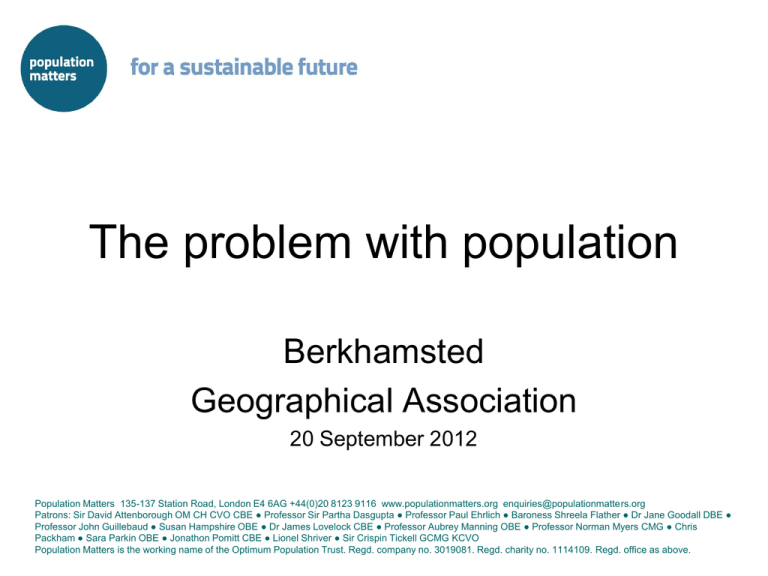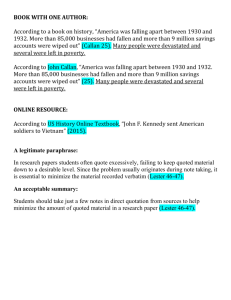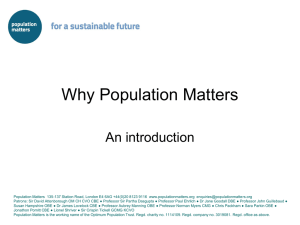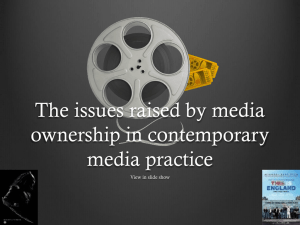
The problem with population
Berkhamsted
Geographical Association
20 September 2012
Population Matters 135-137 Station Road, London E4 6AG +44(0)20 8123 9116 www.populationmatters.org enquiries@populationmatters.org
Patrons: Sir David Attenborough OM CH CVO CBE ● Professor Sir Partha Dasgupta ● Professor Paul Ehrlich ● Baroness Shreela Flather ● Dr Jane Goodall DBE ●
Professor John Guillebaud ● Susan Hampshire OBE ● Dr James Lovelock CBE ● Professor Aubrey Manning OBE ● Professor Norman Myers CMG ● Chris
Packham ● Sara Parkin OBE ● Jonathon Pomitt CBE ● Lionel Shriver ● Sir Crispin Tickell GCMG KCVO
Population Matters is the working name of the Optimum Population Trust. Regd. company no. 3019081. Regd. charity no. 1114109. Regd. office as above.
Introducing Population Matters
• Population Matters is the leading population charity in the UK. Our
vision is of a global population size providing a good standard of
living for all, a healthy environment and environmental sustainability.
• Our activities are based on our charitable aims of advancing:
– the education of the public in issues relating to human population
worldwide and its impact on environmental sustainability;
– research to determine optimum and ecologically sustainable human
population levels and to publicise the results of such research; and
– environmental protection by promoting policies in the United Kingdom
and other parts of the world that will lead or contribute to the
achievement of stable human population levels which allow
environmental sustainability.
• We have over 3000 members from some 30 countries
Slide 2
Introducing the speaker
• Simon Ross, Chief executive
• Simon has been managing for and advising on improved
performance for leading public, private and third sector
organisations for almost thirty years. His experience in
management consulting, marketing and marketing
research has been on both the client and agency side
and he has post graduate qualifications in marketing and
market research.
• He became involved in Population Matters through a
conviction that population growth underlies many of the
problems of today’s world.
Slide 3
Do you have?
• No other siblings (brothers and sisters)
• One other sibling (there are two of you)
• Two other siblings (there are three of you)
• Three or more other siblings (there are
four or more of you)
Slide 4
Key points
• Is population a problem?
• If so, should we do something about it?
• If we should, what should we do about it?
• What do you think?
Slide 5
What do British people think?
• Proposition: Are the world and UK
populations too high?
• Result: 80% said yes.
• YouGov poll for OPT in 2011
Slide 6
Is this a new concern (BC)?
•
•
•
Stasinos – poet 776 – 580 BC
“There was a time when the countless tribes of men, though widedispersed, oppressed the surface of the deep-bosomed Earth, and Zeus
saw it and had pity and in his wise heart resolved to relieve the all-nurturing
Earth of men by causing the great struggle of the Ilian war, that the load of
death might empty the world. And so the heroes were slain in Troy, and the
plan of Zeus came to pass.”
Confucius – philosopher 551 – 479 BC
“Excessive (population) growth may reduce output per worker, repress
levels of living for the masses and engender strife.”
Aristotle – philosopher 384 – 322 BC
“One would have thought that it was even more necessary to limit
population than property…The neglect of this subject, which in existing
states is so common, is a never-failing cause of poverty among the citizens;
and poverty is the parent of revolution and crime”
Slide 7
Is this a new concern (CE)?
• Tertullian – writer and theologian 160 – 220
“The strongest witness is the vast population of the earth to which
we are a burden and she scarcely can provide for our needs.”
• Nicolas Machiavelli – writer 1469 – 1527
“When every province of the world so teems with inhabitants that
they can neither subsist where they are nor remove themselves
elsewhere… the world will purge itself in one or another of these
three ways (floods, plague and famine).”
• Thomas Malthus – clergyman and scholar 1766 – 1832
“Population, when unchecked, increases in a geometrical ratio.
Subsistence increases only in an arithmetical ratio.”
Slide 8
What affects animal population size?
• Food availability
• Disease prevalence
• Predation
• Procreation level
Slide 9
In other words,
• The population of a species grows until:
– The food runs out; e.g. seasonal die off
– Disease spreads in overcrowded conditions
– Predators increase
– Breeding reduces.
• Usually, things tend to balance out.
Slide 10
Which country is this?
Slide 11
Imbalance - lack of predators
• Rabbits introduced to Australia
– Plenty of food
– No natural predators
– High birth rate
• Result – enormous and sometimes
permanent ecological destruction
• Human response - Introduction of disease
- myxamotosis
Slide 12
On the other side of the world
Slide 13
What’s the problem?
Slide 14
Overshoot – lack of food
• Reindeer in St. Matthew Island, Alaska
– 29 individual animals introduced
– No predators
– Population rose to a peak of 6,000
– Lichen eliminated through overgrazing
– Population fell back to 50 over 20 years
Slide 15
Are humans different?
• Are we subject to the same constraints
– Food availability
– Disease prevalence
– Predation
– Procreation level?
• Or can we rise above these limits through
human ingenuity?
• It is a bit of both
Slide 16
Human population historically
Fairly flat
Slide 17
Famine victims in India
Slide 18
Food - deaths from starvation
• Between 108 BC and 1911 AD there were
no fewer than 1,828 major famines in
China or one nearly every year in one or
another province.
• There were 95 famines in Britain during
the Middle Ages.
Slide 19
Which disease is this?
Slide 20
Disease - deaths from disease
•
•
•
•
•
•
•
•
Antonine plague 5m
Plague of Justinian 25m
Black Death 100m
The American conquest 1.5m
Russian cholera pandemic 1m
Russian flu 1m
1981 flu pandemic 75m
HIV/AIDS 25m
Slide 21
Which war is this?
Slide 22
Predator equivalent - deaths from wars
•
•
•
•
•
•
•
•
•
•
World War II 60-72m
An Shi rebellion 36m
Mongol conquests 30-60m
Qing conquest 25m
World War I 20m
Taiping rebellion 20m
Second Sino-Japanese war 20m
Dungan revolt 8-12m
Tamurlane conquests 10-20m
Russian civil war 5-9m
Slide 23
Limiting childbirth
Slide 24
Limiting procreation historically
•
•
•
•
•
•
•
Celibacy (religious orders)
Later marriages
Abstinence e.g. extended breastfeeding
Birth control methods
High child mortality
Infanticide
Geriatricide
Slide 25
Examples of overshoot
• A society's adaptive capacity may be reduced by either a sharp
increase in population or societal complexity, destabilizing its
institutions and causing massive shifts in population and other social
dynamics.
• In cases of collapse civilizations tend to revert to less complex, less
centralized socio-political forms using simpler technology. These are
characteristics of a Dark Age.
• Examples of such societal collapse are: the Hittite Empire, the
Mycenaean civilization, the Western Roman Empire, the
Mauryan and Gupta Empires in India, the Mayas, the Angkor in
Cambodia and the Han and Tang dynasties in China.
Slide 26
What is this pile made of?
Slide 27
Imbalance – lack of predators
• European migration to North America
– Plenty of food
– No natural predators
– High birth rate
• Result – Enormous ecological destruction
– Bison almost wiped out
– Carrier pigeons wiped out
– Newfoundland cod wiped out
– Many whale species almost wiped out
Slide 28
Where is this and what is missing?
Slide 29
Overshoot – lack of timber
• Easter Island
– The first-recorded European contact with the island
was on 5 April 722 when Dutch navigator Jacob
Roggeveen visited and estimated there were 2,000 to
3,000 inhabitants on the island.
– Archaeologists estimate the population may have
been as high as 10,000 to 15,000 a few decades
earlier.
– Fossil pollen analysis shows that the main trees on
the island had gone 72 years earlier in 1650.
Slide 30
What changed in the last 200 years?
Slide 31
What changed in the last 200 years?
• Food availability rose – Agricultural
revolution; Green Revolution
• Disease prevalence fell – Modern
medicine and public health
• Predation fell – Deaths from war falling
• Survival rate rose – Falling infant mortality
• Made possible by exploiting fossil fuels
Slide 32
Did anyone notice?
•
•
•
•
•
•
•
•
•
•
•
Albert Einstein
Helen Keller
John Maynard Keynes
Jawaharlal Nehru
Kenneth Boulding
Jacques Cousteau
Richard M. Nixon
Norman Borlaug
Robert McNamara
Spike Milligan
James Lovelock
Slide 33
•
•
•
•
•
•
•
•
•
•
•
Digby McLaren
Isaac Asimov
Prince Philip
James P. Grant
Professor Albert Bartlett
George H.W. Bush
Gore Vidal
Queen Elizabeth II
Sir David Attenborough
Maurice Strong
Martin Luther King
Promoting responsible parenting
Slide 34
A couple considers their options
Slide 35
But many FP programmes lapsed
• Opposition
–
–
–
–
–
Fundamentalist religions - fertility is God’s will
US religious right – opposition to abortion
Political right - the market will solve our problems
Political left – socialism will solve our problems
Some feminists/ civil rights advocates – top down
target led population programmes led to undue
pressure (China, Indian state of emergency)
• HIV/AIDS need for funding
Slide 36
Birth rates fell but not by enough
Children
per
woman
2.1 per
woman =
long term
stability
Slide 37
Human impact is more than population
Log
scale
Slide 38
What are the consequences - I?
• Falling:
– water supplies in aquifers and glaciers
– agricultural land area and fertility
– freshwater fish and sea fish stocks
– biodiversity and habitats worldwide
– Oil, coal and gas reserves
– mineral and plant resources
– arctic and ocean health
• Changing climate and weather
Slide 39
What are the consequences - II?
• Growing
– Demand for housing and overcrowding
– Pressure on green belt and countryside
– Infrastructure costs and disruption
– Traffic congestion and transport crowding
– Pollution: air, noise, light
– Reliance on wind farms, nuclear, fracking,
coal fired power stations, biofuels
– Reliance on intensive farming and GM food
Slide 40
Berkhamsted size triples in 100 years
Slide 41
What does the future hold?
Drivers of change
• Population growth
• Industrialization of global south
• Meat based diet becomes more common
Consequences of change
• Urbanization,ageing, migration
• Progressive elimination of wildlife
• Will there be enough food for all?
Slide 42
Poverty currently extensive
• 3 billion people have an income of less
than U.S. $2.5/day
• 1.5 billion people have an income of less
than US$1.25/day
• Almost a billion people lack access to
sufficient food or clean drinking water
Slide 43
Where is the population going?
16 billion
10 billion
6 billion
Slide 44
What decides future growth?
• Increasing longevity – living longer
• Population momentum – youth cohort size
• Falling birth rate – children per woman
Slide 45
Increasing longevity
• Improved nutrition, public health and
medicine
– Infant and child survival still rising
– People living longer worldwide
• Trend slightly moderated by
– Increasing obesity and lack of exercise
– Virus developing resistance to drugs
Slide 46
Increasing longevity - world
Period
Slide 47
Both sexes
combined
Male
Female
2010-2015
69.3
67.1
71.6
2015-2020
70.4
68.2
72.8
2020-2025
71.4
69.2
73.8
2025-2030
72.4
70.1
74.8
2030-2035
73.3
71.0
75.7
2035-2040
74.1
71.8
76.5
2040-2045
74.9
72.5
77.3
2045-2050
75.6
73.2
78.0
2050-2055
76.3
73.9
78.7
2055-2060
76.9
74.6
79.3
Will rise by
seven years
in next 55
years
Population momentum
• There are more young people than ever
before due to better infant survival and
past high birth rates
• Even if they each have no more children
than their parents had, the result will be a
higher population
Slide 48
Population momentum
Slide 49
Falling birth rate
• The birth rate is falling in most countries
• 40% of people live in countries with subreplacement birth rates
However,
• Some countries still have high birth rates
• Forecasts depend on access to family
planning and a desire for smaller families
Slide 50
Asia is slowing down; Africa is not
Asia
Slide 51
Africa
Rising urbanization by continent
Slide 52
Which country is this?
Slide 53
Rising urbanization – major cities
Rank
Metropolita
Country
n area
1
Tokyo
2
Seoul
3
4
5
6
7
8
9
Mexico
City[3]
New York
City[4]
MumbaiBombay
Jakarta
São Paulo
Delhi
Los
Angeles[5]
Japan
South
Korea
Population
Density
Population Area (km2)
(People/km
2)
32,450,000 8,014
4,049
Maximum city density is
nine times that of London
20,550,000 5,076
4,048
Mexico
20,450,000 7,346
2,784
United
States
19,750,000 17,884
1,104
10
OsakaKobe-Kyoto
Japan
17,375,000 6,930
2,507
India
19,200,000 2,350
8,170
Indonesia
Brazil
India
United
States
18,900,000 5,100
18,850,000 8,479
18,600,000 3,182
3,706
2,223
5,845
11
12
Shanghai
Manila
China
16,650,000 5,177
Philippines 16,300,000 2,521
3,216
6,466
13
Hong KongHong Kong 15,800,000 3,051
Shenzhen
5,179
17,877,097 10,780
1,415
14
15
16
17
Slide 54
Kolkata
Moscow
Cairo
Buenos
Aires
18
London
19
20
Beijing
Karachi
India
Russia
Egypt
15,100,000 1,785
15,000,000 14,925
14,450,000 1,600
8,459
1,005
9,031
Argentina
13,170,000 10,888
1,210
12,875,000 11,391
1,130
12,500,000 6,562
11,800,000 1,100
1,905
10,727
United
Kingdom
China
Pakistan
Rising migration
• Total number of
migrants rising
• Reasons
– Greater ease of travel
– Greater information
about destinations
– Globalising culture
– Economic and
ecological pressures
Slide 55
Main migratory routes
Slide 56
Over half a million people settle in the UK every year
So what should we do?
• We can:
–
–
–
–
Make greater use of existing technologies
Develop new technologies
Reduce waste
Move to greater equality of consumption
• But these are:
–
–
–
–
Slide 57
Often difficult to implement
May have a limited or temporary impact
Have uncertain and negative side-effects
Complementary, not alternatives
Here is one approach
Slide 58
Population policies - China
• Before the policy, there was a sharp reduction from more than five
births per woman in the early 1970s to 2.5 in 1980.
• One third of population is subject to the one-child policy.
• Violators are fined and may lose their work bonus.
• The fertility rate fell from 2.63 births in 1980 to 1.61 in 2009
• However, the policy itself is probably only partially responsible for
the reduction in the total fertility rate.
• Criticisms: Was such a draconian approach required? Is it fairly
applied? Were there human rights abuses? Is son preference
worsened? Do single children lose out?
• Was China right or wrong?
Slide 59
Population policies - Iran
• Declared Islam favoured families with only two children".
• Introduced free contraceptives - pills, condoms, IUDs, implants,
tubal ligations, and vasectomies, including mobile teams.
• Birth control classes required before a couple could get married.
• After the third child, withdrew food coupons, paid maternity
leave, and social welfare subsidies.
• Population growth fell from 3% a year between 1956 and 1986 to
0.7% a year by 2007.
• Was Iran right or wrong?
Slide 60
Population policies – Population
Matters
• Universal user-led access to a range of family planning services
• Quality sex education/ support to reduce unplanned pregnancies
• Encouragement for individuals to make responsible decisions on
family size (one or two, not three or more)
• An end to subsidies of larger families, except in proven need
• An end to discrimination against women and equal access for
women to education, decision-making and resources
• Are we right or wrong?
Slide 61
Political sensitivities still exist
Developing countries
• End child marriage
• End female
circumcision
• Give women social
and economic rights
• Legalize abortion
• Legalize same sex
relationships
Slide 62
Developed countries
• Give official call for
smaller families
• Cut child benefits and
child tax credits
• Advertise
contraception on TV
• Reduce net migration
to a rough balance
Key points
• Is population a problem?
– Yes, it is
• If so, should we do something about it?
– Yes, we must
• If we should, what should we do about it?
– Provide family planning and promote smaller
families
Slide 63
End with good news: Will and Kate
Prince William reveals wish
for two children
The Duke of Cambridge has reportedly
revealed he would like to have two children
with his wife. Prince William made the
comment when asked how many children he
would like, during the second day of the
couple's Diamond Jubilee tour to Singapore. A
teenager at one walkabout said the prince had
responded by saying "he was thinking about
having two".
Source: BBC 12 September 2012
Slide 64
SafeSearch on












